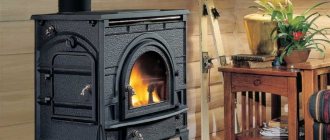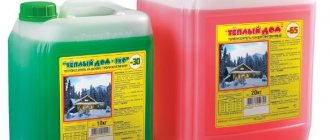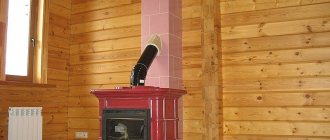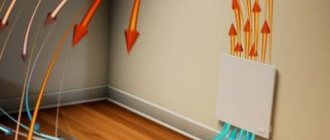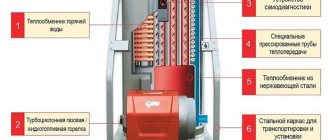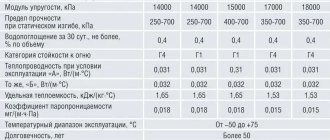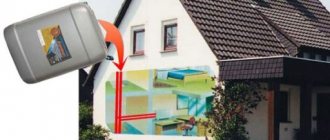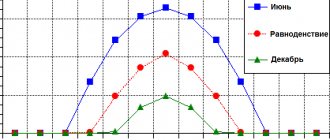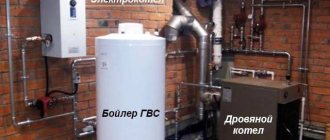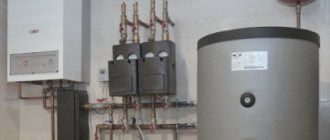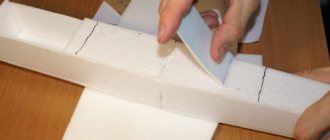In most regions of our country, winters are quite severe, so the issue of home heating is one of the key issues for owners of country houses and dachas.
air-heated fireplace
Of all the heating structures for a summer house or country house, a fireplace perhaps evokes the warmest associations.
It brings a special atmosphere of comfort, creates a homely mood, but at the same time, in its classic design, it does not have the highest efficiency. Because of this, many people believe that heating a home with a fireplace is an expensive pleasure. An air-heated fireplace can heat even a large home. To do this, you just need to change the standard heat transfer scheme and implement convection. We will talk about how to do this with your own hands in this article.
Principle of operation
The key to an air-heated fireplace is the casing and ductwork throughout the home.
Principle of operation
The thermal casing of the fireplace not only accumulates heat, but also allows it to be redistributed in the desired direction. This minor detail greatly improves the efficiency of heating a room with a fireplace and increases its efficiency.
The convection method of heating a room works on the simplest laws of physics. The warm air that comes from the lower pipes rises and heats the room.
Fireplace with air jacket
Thanks to a special liner located in the firebox, the air is heated. In this case, the liner is surrounded by pipes that are connected to the pipe distribution. Due to the operation of fans, warm air begins to move and quickly moves around the room, heating it.
Diagram of air heating in the fireplace
Also, air movement can occur not due to forced ventilation, but due to the force of gravitational attraction. The temperature difference between cold and hot gas ensures air movement throughout the room.
But in this case, the number of pipe turns should be minimal, otherwise the gravity system will not be able to ensure natural air circulation.
Circulation of warm air in the house
Thus, the operation of a convection fireplace is realized in two ways:
- The upward flow from the fireplace insert lifts warm air to the top of the room.
- A downdraft, on the contrary, directs cooler air towards the firebox.
If the owner is faced with the task of heating a large house using one standard fireplace, then he will have to make a more complex air duct circuit, where hot air will be supplied to the rooms due to the operation of fans.
Scheme of operation of air heating in the house
With the correct organization of the system and strict compliance with all the laws of physics, with the help of one fireplace with an air casing, you can heat even a two-story house.
Budget heating stoves made of cast iron or steel
Another good way to save money is to buy a simple cast iron or metal stove for your garden or home.
Such stoves are characterized by small dimensions, a simple design and a small combustion chamber.
But they heat small rooms with high efficiency: they quickly heat up the space and can even successfully accumulate heat - if the stove is made of cast iron: a heat-intensive material. The good functionality of such stoves also consists of the following points:
- the presence of a convenient hob for cooking or heating food during heating
- possibility of connecting pipes for heating adjacent rooms
- equipped with combustion air supply systems, flue gas afterburning systems, and a “clean glass” system
- often: top chimney connection to save living space
- quick heating of the stove, correspondingly quick filling of the room with heat
Advantages of an air-heated fireplace
What is the advantage of the convection type of heat exchange compared to the standard fireplace design? Let's look at this issue in more detail:
- An ordinary fireplace, without any additional devices, works according to the standard scheme: the heat in it is maintained exactly until the firewood burns.
Fireplace with closed firebox
This is precisely what calls into question the efficiency of such a unit in modern living conditions. If you increase the flow of additional air into the fireplace insert, this will help improve the combustion process and ensure its stable operation. The introduction of air heating into the fireplace reduces fuel consumption by 20%.
- Smoke exhaust ducts are necessary to remove combustion products. But if, in addition to arranging these pipes, additional channels were laid into which air heated by convection would flow, they would provide an additional increase in temperature.
Fireplace with water and air heating
An air fireplace enclosure helps raise the temperature in your home in several ways:
- Radiation - direct heating of air from an open firebox in a fireplace.
- Heat transfer - heating the walls of the fireplace and direct transfer of hot air into the room.
- Convection is the process of mixing cold and hot air flows in a house.
Fireplace with water and air heating
The only point that needs to be taken into account when arranging a fireplace with air heating is planning such a device at the stage of building a house. This is directly related to the thickness of the walls of the house and the features of their construction.
Air-heated fireplace in detail
The air fireplace operates on a closed firebox. Many manufacturers immediately offer ready-made kits with a casing, which are a mono block. There are gaps inside through which air passes repeatedly.
In terms of cost, an air fireplace is much cheaper than a similar unit with a water circuit. At the same time, it is in no way inferior in efficiency and heat transfer, if, of course, the ventilation wiring is done correctly.
Typical diagram of connecting a fireplace to a heating system
A feature of fireplaces with a water circuit is double heat transfer: first, the firebox heats the water, and then the radiator heats the air itself. Here, instantaneous heat transfer occurs due to convection currents.
Forced convection allows you to change the heating radius from 3 meters to 10 meters. Also, using convection, you can change the climatic conditions of your home by increasing or decreasing humidity.
Of course, this method will require additional financial investments, but it will ensure an optimal level of comfort in a country house.
Microclimate in the house
Which company should you choose?
There are many companies producing such heating devices. Experts recommend paying attention to well-known brands that use higher quality and proven materials.
These include:
- Kratki is a Polish brand with an optimal pricing policy and high efficiency. Wood-burning models have high power, sophisticated ergonomics and adjustable door pressure. The appearance of the fireplaces is modest, but the company focuses on functionality.
- Meta is a Russian company that has been on the market for a long time. Produces optimal fireplaces for small spaces. A distinctive feature is that they do not tolerate damp and resinous firewood; it is recommended to burn with dry hardwood fuel.
- Spartherm is a German brand that produces models with and without a water circuit, as well as fireplaces burning coal, gas and peat briquettes. We also manufacture fireplaces upon customer request.
Rating updated September 12, 2021.
Air-heated fireplace design
Traditionally, an air fireplace consists of the following elements:
- Fireplace insert.
- Portal.
- Air pipes that increase the thermal efficiency of the unit.
- A fireplace mantle that distributes heat.
- Fan.
- Filter.
- Ventilation grates.
- Firebox stand.
- Distributor and air tees.
The advantage of such heating is that it can be implemented in areas remote from the benefits of civilization. Where electricity is not provided. And at the same time, one fireplace can heat a fairly large house with several rooms.
Air hood for fireplace
The presence of two floors will require adding a special pump to the standard arrangement of an air fireplace, which will perform forced circulation of warm air.
Air heat exchange occurs in a closed cycle.
Stoves and fireplaces
This is a special type for saunas and baths. Some owners install such models, but they already use them not only as a heating or decorative device, but also for cooking. More detailed instructions are always included in the kit.
Both wood and gas are good fuel.
Fireplace stoves can be:
- open;
- closed;
- half open.
Features of designing a fireplace with a casing
Whatever configuration, power and size you intend to implement a fireplace, a prerequisite for convection heat exchange is the installation of fans. With standard heating of a house by a fireplace, air circulation will be carried out only due to the temperature difference (air density).
Algorithm for air movement in the casing
Naturally, the efficiency of such convection is extremely low. When creating artificial convection, the intensity of the fireplace will be created by the direction of air flows.
The location of the fans is also of great importance. The main feature of this design is the location in such a way that they supply cold air from below, and not from the inside. Otherwise, the reverse process may occur.
We should not forget about the noise threshold in the room. When arranging a fireplace, it must be minimized, otherwise, despite the heat emitted by the heating device, it will be extremely uncomfortable to be in the room.
Having decided to install a fireplace with air heating at the dacha, I would immediately like to warn you that this is not an easy undertaking. If you are an absolute beginner in this matter, then it is better to order a diagram of the location of the fan and pipes from a specialist.
System elements
The principle of creating such a design is as follows: cold air is taken from below by fans and goes to the firebox, where it is heated to the required temperature. Then it enters the walls and passes through special channels into the facing casing of the chimney.
Air movement in the casing
The metal chimney also, in turn, produces heat, increasing the efficiency of the fireplace. Here, maximum circulation of hot air occurs, which, under the influence of a fan, is directed into the room.
Video. How to correctly calculate air heating
For the design of this heating system, a closed firebox is suitable, which accumulates and retains heat as much as possible. Such a heating system allows you to achieve a maximum efficiency of 80-85%.
In order to achieve maximum design efficiency, it is necessary to minimize the network of pipes, channels and the number of their bends. If the length of the pipe does not exceed 3 meters and does not have many bends, then natural circulation may be sufficient. With other parameters, you cannot do without additional fans.
Air ducts are best made of steel or aluminum.
Important! An important element when planning an air fireplace heating system is the layout of the house. If the house has two floors, then you will most likely need several fans. For a one-story house with a horizontal pipe outlet, one fan will be enough.
Diagram of air heating in the fireplace
Fireplace inserts made of cast iron and steel: advantages and disadvantages and lining features
Route User FORUMHOUSE
I want to install a wall-corner fireplace with a glass-covered firebox in my house for decorative and aesthetic purposes. Heating qualities are secondary. The primary ones are beauty, reliability, ease of installation and low maintenance. I formed for myself the basic requirements for a fireplace. This:
- High quality manufacturing of the firebox so that nothing cracks during use of the fireplace.
- Acceptable price.
- The fireplace should not smoke or burn out air.
- The system must be secure.
- The glass should not be covered with soot.
But most importantly, I still haven’t decided which material is better for the fireplace insert: steel or cast iron?
Traditionally, cast iron is used to create fireplaces and other heating appliances. Fans of this material give the following arguments in favor:
- Cast iron does not deform during prolonged heating, is heat-resistant and can withstand quick/sharp start-up when operating the fireplace.
- Cast iron has good heat capacity.
- Cast iron looks beautiful in the interior.
Andrey Kozyrev
Indeed, the high heat resistance and attractive appearance of cast iron make it possible to successfully use this material for the manufacture of fireplace inserts. But cast iron has a number of features that you need to know about in order to make an informed choice of firebox material.
Disadvantages of cast iron:
- Fragility. This feature must be taken into account when operating the fireplace. Cast iron can crack if struck sharply, for example by a poker or a log carelessly thrown into the firebox.
- The complexity of welding cast iron parts. Cast iron fireplace inserts and stoves are assembled from fairly flat panels, using screw connections, and the joints are sealed with modern heat-resistant materials.
- There are restrictions on the size of the firebox and the impossibility of repairing the fireplace body by straightening, etc.
Let's move on to the advantages of steel fireplace inserts:
- Steel is a high-tech material. It lends itself well to metalworking, repair, and is not afraid of impacts.
This improves the consumer properties of the fireplace.
In contrast to cast iron products, steel is easily welded, which ensures a significantly higher gas tightness (tightness) of the fireplace.
- Steel is ductile, so the size of modern fireplace inserts has increased significantly.
The width of the steel firebox of 1200 or 1500 mm has long become the standard. While for a cast iron firebox a width of 1100 mm is the technological limit. In fact, the size of a steel firebox is unlimited (as a rule, fireboxes over one and a half meters wide are made to order).
The disadvantage of steel is the low heat resistance of its budget grades.
This feature of the material can be corrected by lining the fireplace insert with refractory materials . For example, some manufacturers use fireclay or cast iron as a refractory lining for a steel firebox.
When combining materials, the steel structure of the firebox bears all the mechanical loads, and cast iron or fireclay bears the temperature loads.
Andrey Kozyrev
For thermal protection of a steel fireplace insert, you can use cast fireclay (thermoconcrete). This is a modern material with a heat resistance of 1320 °C. Thermoconcrete has a very smooth and attractive surface, which promotes self-cleaning of the internal surface of the firebox. Two colors are available - black and white. The white lining harmonizes well with the light finish of the fireplace. Soot is not visible on the black lining (although soot on light-colored lining burns out as the fireplace heats up, i.e., it cleans itself) and its color scheme resembles classic black cast iron.
Basic rules for installing a fireplace with air heating
It is best to install a fireplace fan in a utility room. Firstly, this will allow not to disturb the aesthetics of the interior, and secondly, it will reduce the noise threshold created by the operating device.
Important! The operation of such a fireplace requires a particularly careful approach. Due to the constant operation of the fan, soot accumulates on the filter, which must be constantly cleaned. Otherwise, the efficiency of such a fireplace may be significantly reduced.
To avoid noise when the fireplace is operating, choose a pipe diameter with a round cross-section. For such a heating system to work effectively, each room must have a ventilation hole with a grille. Therefore, design must take place at the stage of building a house, otherwise it will take a lot of effort and time to equip an air fireplace in the house.
Anemostats or closed diffusers help to warm the room from all sides. The shape of the diffuser can be round or square; this does not affect the functionality of the system in any way.
Diffuser
The heating system with an air fireplace is suitable for the entire house, except for rooms where separate ventilation is provided: bathroom, toilet, kitchen. If you omit this factor, the warm air circulation system in the house may be disrupted.
The convection chamber of the fireplace is made of plasterboard, and the frame is made of galvanized profile.
To prevent heat from entering the ceiling, it is necessary to provide a cutoff.
Thermal cut-off under the ceiling
This ensures uniform pressure, ventilation in the system and maximum fire safety, helping to prevent fires. To do this, heating with an air fireplace must take into account certain safety measures not only during operation, but also at the stage of construction of the unit.
Let's look at the key points of the arrangement:
- The fireplace insert must stand on a sturdy stand made of brick.
- The foundation for the fireplace must be separate from the main foundation of the house.
- The system must be covered with plasterboard sheets.
- Air ducts must be routed throughout the house.
- The air duct assembly must be located in the technical room.
Let's look at the main advantages of a casing for an air fireplace:
- Increased efficiency. Compared to a conventional fireplace, which provides an efficiency of 30-40%, air heating increases productivity up to 80-85%, depending on the duct and pipe arrangement system.
- Fuel consumption is reduced by 20%. Even after the solid fuel has completely died out, warm air continues to move around the room.
Air heating operation diagram
- Using hot smoke. If in a standard home heating system with a fireplace, the chimney pipe is used only as a removal of combustion products, then here the metal casing provides additional heating to the room, releasing warm air into the room.
- The maximum gas temperature during combustion is 1700C. Do you agree that it is very irrational not to use this resource? A special air duct, which is equipped with an air fireplace, ensures the circulation of hot air throughout the house.
Video. Heating your home with an air fireplace
The listed advantages of such a heating system speak very eloquently about the need to implement this project.
Air heating system
We have already reviewed the most effective solutions related to the production and installation of fireplaces. But releasing heat and using it as much as possible are two different issues that will have to be solved separately from each other.
Let's remember physics and take into account that the thermal conductivity of air is low. Therefore, filling a room with warm air is possible only by transfer of matter, that is, convection. Natural convection is good when each room has its own source of energy. In order for one heating fireplace or stove to heat the whole house, it is necessary to direct air flows from it to all rooms.
The fireplace insert is designed in such a way that cold air enters from below. Since the possibility of natural convection is immediately excluded, a fan is used to pump in cold air. Getting into the space between the combustion chamber and the body, it quickly heats up.
Here it is necessary to understand that the maximum surface area of the chamber helps to increase efficiency. But the dimensions of the chamber should not exceed the dimensions of the body; moreover, too small a gap between the walls will create unnecessary resistance. Technological calculations and experiments made it possible to achieve optimal geometric parameters. That’s why it’s theoretically possible to make a heating fireplace yourself, but it’s not recommended.
The heated air enters the air ducts and is distributed to different rooms. This method is convenient because it serves as heating for a two-story house. It is advisable to plan a fireplace for heating the house during construction work. After all, the chimney and air ducts must be built into the wall. The only drawback of the air system is its dependence on power supply and the excessive noise of the fans.
Choosing the right fireplace for air heating
Having decided to install air heating in a house, it is very important not only to develop a competent project diagram, but also to choose the right fireplace.
The standard system for choosing a fireplace for your home will not work in this case. Traditionally, we choose the power of the firebox based on the area of the room, but other rules will apply here.
The fact is that a firebox that is too powerful will lead to overheating of the room, in which the owners will simply feel uncomfortable staying. You will have to constantly monitor the amount of firewood, ventilate the room, which will require additional hassle and can lead to colds, etc.
Calculation table for fireplace power
To correctly calculate the power of a fireplace, it is necessary to take into account not only the area of the room, but also the number of rooms, floors in the house, the number of windows and the type of ventilation system.
Features of installing stove heating in a two-story house. Tips for laying bricks
Stove heating in a private home makes it possible to be independent from a centralized system and provides a number of positive aspects. There is no need to wait until the heat is turned on or off according to a schedule, the ability to control the level of comfortable temperature in the house, as well as the cost of paying for fuel. Installing a stove in a two-story house can be an expensive undertaking, but as practice and people's reviews show, it is worth it. To build a stove in a two-story house, you first need to make its design, carry out the necessary calculations, and only then begin the main work. A nuance that you need to pay attention to first of all is that the oven requires a lot of space. The process of heating the entire house does not occur immediately, but gradually. It is not possible to control the air temperature throughout the house.
In order to build a high-quality stove structure, the first thing you need to do is take care of a reliable foundation for the house, and before that, calculate the weight of the finished structure. A hole for the foundation is dug at a level of at least 1 meter, and a reinforced concrete slab is used as a floor. Such structures must be installed along the length of the internal load-bearing walls.
The stove in a two-story house comes in two types: single-furnace or double-furnace. The main firebox is always located on the first floor. On the second one you can install a working fireplace, which makes it possible to heat the house faster.
